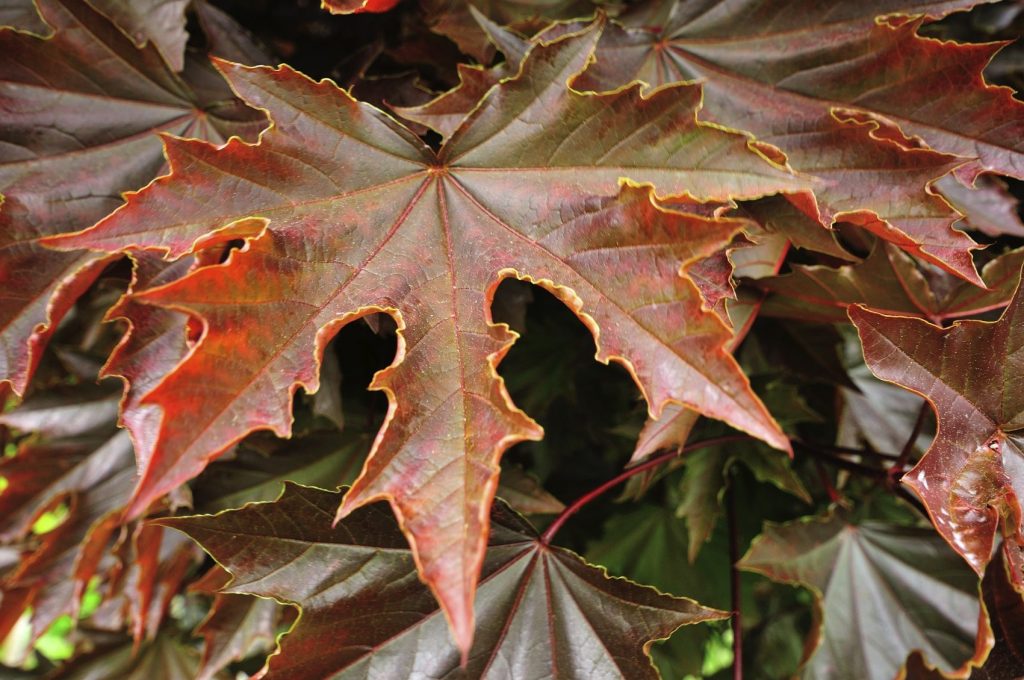Discover the world of maple trees – a vital part of our natural landscape and gardens.
In this guide, we dive into the intricacies of maple bark identification, leaf patterns, and other distinguishing features.
Whether you’re an enthusiast or a novice, understanding the characteristics of different maple tree types can transform your garden or outdoor space.
Embark on a journey to uncover the essence of maple trees.
By the end of this guide, you’ll be equipped with the knowledge to identify various species, making it easier to choose the right maple tree for your needs.
Let’s explore the beauty and diversity of maple trees together.
Understanding Maple Trees
Maple trees, known for their stunning deciduous nature, are a favorite among gardeners and nature enthusiasts.
As deciduous trees, they uniquely change leaf color and shed leaves annually in autumn.
This feature adds a dynamic visual element to any landscape.
A key aspect of maple trees is their bark, which serves as a primary focus for maple bark identification.
The bark is typically narrow, with small and dark brown furrows varying across species.
Distinctive winged fruits accompany this rich foliage.
The leaves, often lobed and possibly round, transition through a spectrum of colors – from green to red, yellow, orange, and finally to dark burgundy as the seasons change.
In terms of size, maple trees can reach impressive heights of up to 150 feet, classifying them among the larger species of deciduous trees.
This size variation adds to their appeal, allowing them to fit into diverse landscape designs.
Key Facts About Maple Trees

Maple trees, belonging to the Acer Plant Genus, boast over 120 species worldwide.
Notable among these are the Sugar Maple (Acer Saccharum) and Red Maple (Acer Rubrum), with others like the Big Leaf Maple (Acer Macrophyllum), Amur Maple (Acer Ginnala), and Hedge Maple (Acer Campestre) also prominent.
One distinctive feature of maple trees, particularly relevant for maple bark identification, is their varied and high-quality wood.
Maple wood is widely used in manufacturing pool cue shafts, basketball bats, hardwood flooring, and beautifully crafted furniture.
Additionally, maple trees are celebrated for their sweet maple syrup, primarily derived from the Sugar Maple species, known for producing the highest quality syrup.
The maple leaf symbolizes strength and endurance, highlighted by its iconic presence on the Canadian flag.
Its beauty and significance make the maple tree a revered species in the natural world and cultural symbolism.
1. Bark of Maple Tree
A key feature in maple bark identification is the color transformation of the bark as the tree matures.
Initially light, the bark deepens to a rich dark brown over time.
This aging process often results in a unique striped pattern along the trunk, a characteristic that can be instrumental in identifying maple species.
The texture of maple bark varies significantly across different species.
While some exhibit a wrinkled surface with noticeable fissures, others may have a smoother texture.
This diversity in bark appearance is an essential aspect of maple tree identification, offering a visual guide to distinguishing between various maple species.
2. Leaves of Maple Tree
Maple tree leaves are distinctively lobed, usually bearing three to nine lobes.
The shape and serration of these lobes play a crucial role in maple bark identification and differentiating between the various species.
Understanding these subtle differences is key to identifying the over 120 species of maple trees globally.
As seasons change, so do the colors of maple leaves, shifting from green to yellow, orange, and eventually dark burgundy in the fall.
This color transition is aesthetically pleasing and serves as a helpful identifier for maple species.
For instance, the Sugar Maple is known for its five serrated lobes, while the Silver Maple features deeper indentations.
Maple Tree Identification Essentials

Identifying a maple tree involves looking for specific markers. Key indicators include the tree’s leaves, bark, and fruit.
Maple leaves are typically lobed with pointed edges.
Observing the bark’s texture and color is crucial to maple bark identification.
The bark is smoother in younger trees but develops deep fissures and a wrinkled structure as it ages.
The color of the leaves also transitions over time, starting green and gradually darkening.
Another distinctive feature of maple trees is their fruit, known as samaras.
These wing-shaped fruits carry seeds that can travel long distances, aided by the wind.
This reproductive strategy is not only fascinating but also a helpful identification characteristic.
1. Maple Bark Identification Guide
A critical aspect of identifying a maple tree is through its bark, which typically exhibits a range of colors from dark brown to dark reddish-brown.
As the tree ages, the bark develops a unique structure with fissures and vertical scales.
These textural changes are key indicators in maple bark identification.
Each maple species has its bark characteristics.
For example, the Silver Maple is known for its flaky gray bark, while the Red Maple features a dark brown bark with a similar flaky texture.
2. Leaf-Based Identification of Maple Trees
Maple tree leaves are a critical factor in species identification.
These leaves are characteristically lobed, typically with three to five lobes, varying by species.
The deciduous nature of these trees means their leaves undergo a dramatic color transformation through the seasons – from green to yellow, then orange, and finally dark burgundy.
This seasonal change is a key identifier and varies among maple species.
3. Differentiating Between Sugar Maple and Red Maple Trees
While both species can produce sweet syrup, the Sugar Maple is renowned for its superior quality.
Although not as prolific in syrup production, the Red Maple is prized for its aesthetic appeal.
These trees add immense beauty to landscapes and gardens, especially during sunset, with their picturesque hues.
Red Maple Trees
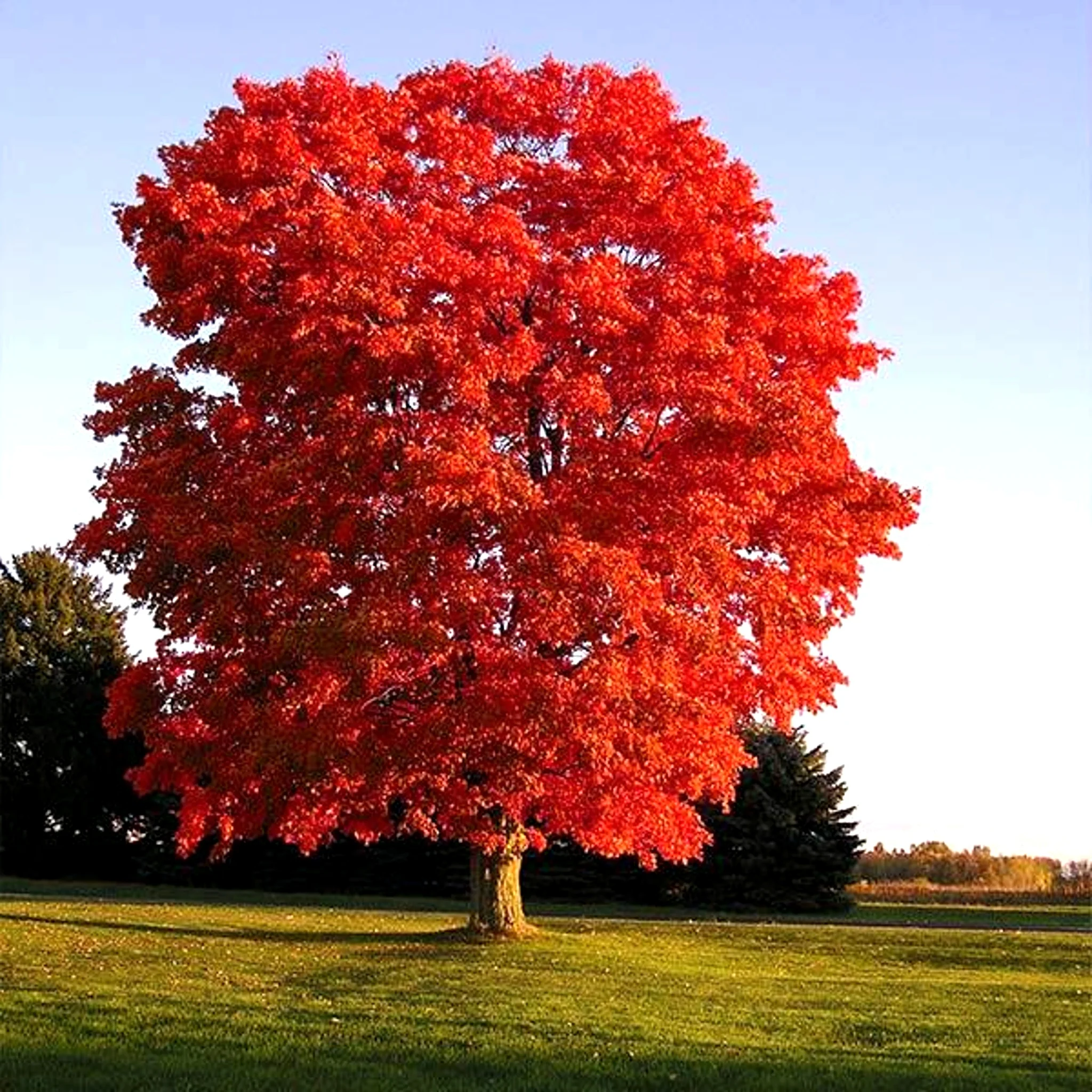
Red Maple Trees are a remarkable species within the Acer genus, easily identifiable by their unique leaf and bark characteristics.
Their leaves start with a light green hue, transitioning to a stunning red in the fall.
The underside of these leaves often has a silvery tone, with serrated lobes and pointed edges.
Unlike Sugar Maple Trees, the lobes of Red Maple leaves are less deeply indented.
A key feature in maple bark identification for Red Maple Trees is their pale gray color, which tends to be thinner than Sugar Maple Trees.
This characteristic, coupled with the distinct leaf color changes, makes Red Maple Trees a popular choice for adding autumnal beauty to landscapes.
Sugar Maple Trees
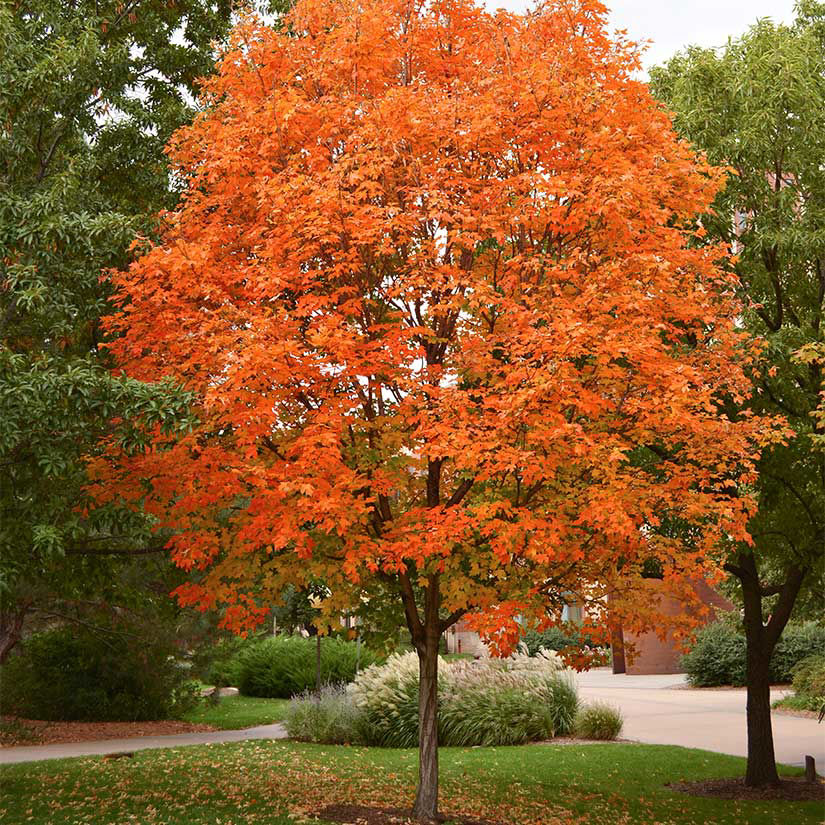
Their leaves, typically having five lobes (three small, two large), start dark green and transition through red, orange, to yellow in fall.
These leaves are large, around 19-20 cm long, with a unique ‘U’ shaped space between lobes.
The bark of Sugar Maple Trees changes with age, starting smooth and becoming more textured over time.
This species is key for producing high-quality maple syrup and adds vibrant color to landscapes in autumn.
Different Varieties of Maple Trees
Explore the diverse world of maple trees, each with unique characteristics ideal for maple bark identification and aesthetic appeal.
This section delves into various species, highlighting their distinct features.
Discover the right maple variety for your landscape as we examine each one.
1. Freeman Maple Tree (Acer freemanii)

Freeman Maple Trees, also known as Autumn Blaze, are notable for their height, reaching 30-50 feet.
Their leaves, initially green, undergo a striking transition from orange to crimson red in fall, contributing to their landscape appeal.
Leaves with deep indentations between the lobes characterize these trees.
The bark, key for maple bark identification, starts as gray with a smooth finish and becomes somewhat furrowed as the tree matures.
2. Japanese Maple Tree (Acer palmatum)

Japanese Maple Trees, known for their versatility, typically grow 30-33 feet tall and can take on a dome-like shape.
They are adaptable, sometimes growing as shrubs in certain regions.
These trees are famous for their leaf color transitions from yellow to bronze and deep red.
Their leaves, about 5 inches long, feature 5-9 lobes resembling outstretched fingers.
Initially green, the leaves dramatically change colors through the seasons.
The bark of the Japanese Maple, crucial for maple bark identification, starts as gray and smooth, evolving into a furrowed texture.
Some varieties even exhibit pink bark, adding to their uniqueness.
3. Silver Maple Tree (Acer saccharinum)

Renowned for their rapid growth, Silver Maple Trees are a striking species among deciduous trees.
They aptly earn their name with a unique leaf coloration – green on one side and silver on the other.
These trees typically reach heights between 52-85 feet, making them a prominent feature in any landscape.
4. Boxelder Maple Tree (Acer negundo)

Also known as Manitoba Maple or Ash Leaved Maple, Boxelder Maple Trees stand out for their adaptability and minimal care requirements.
They can grow up to 78-80 feet, thriving in full sunlight and shaded areas, making them versatile for various landscape settings.
5. Norway Maple Tree (Acer platanoides)
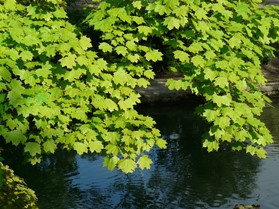
Originating from Europe, Norway Maple Trees are known for their extensive crowns and robust growth, reaching up to 100 feet.
Remarkably adaptable, they flourish in various soil conditions, making them popular for diverse landscapes.
6. Sycamore Maple Tree (Acer pseudoplatanus)

Sycamore Maple Trees, despite their name, are not true Sycamores but belong to the Acer genus.
These large deciduous trees, with dense foliage and expansive branches, grow between 42-63 feet.
Their large leaves and impressive stature make them a prominent feature in any larger landscape.
7. Amur Maple Tree (Acer ginnala)
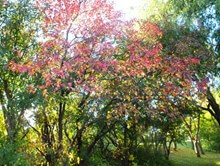
Amur Maple Trees are known for their smaller stature, growing as either compact trees or shrubs, reaching 15-35 feet in height.
They are low-maintenance and adaptable, thriving in full sunlight and various soil types.
Their round, dense crowns and multi-stemmed nature make them versatile for garden landscapes.
8. Big Leaf Maple Tree (Acer macrophyllum)

As the name implies, Big Leaf Maple Trees are distinguished by having the largest leaves among maple species, native to North America.
These towering trees can grow up to 160 feet, making them majestic in any landscape.
Also known as Oregon Maples, they are notable for their grandeur and leaf size.
Summing It Up
In summary, we’ve explored key identification markers and characteristics of various maple tree varieties.
Armed with this knowledge, you’re now equipped to select the ideal maple tree that complements your landscape and enhances its beauty, especially during the serene moments of sunset.
Embrace your newfound expertise in maple trees and confidently choose the perfect addition to your garden.
Best of luck with your maple tree journey – may your choices flourish and bring joy to your landscape!

